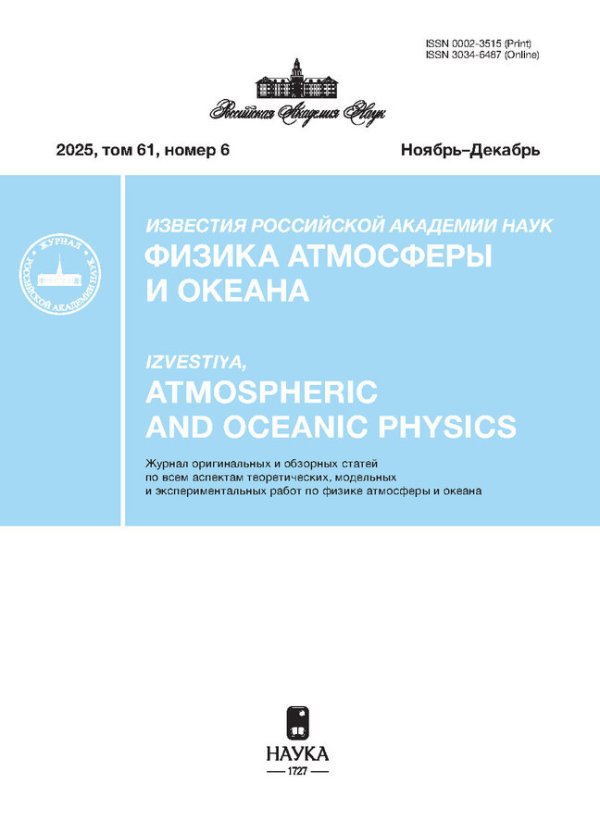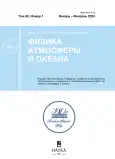Vol 60, No 1 (2024)
Articles
Two-Dimensional Surface Periodic Flows of an Incompressible Fluid in Various Models of the Medium
Abstract
A comparative analysis of the properties of two-dimensional infinitesimal periodic perturbations propagating over the incompressible fluid surface in various representations of the medium density profiles is carried out. Stratified and homogeneous in density viscous or ideal liquids are considered. Calculations are carried out by methods of the theory of singular perturbations. Dispersion relations and dependences of phase and group velocities for surface waves in physically observed variables are given. The change in the meaning of dispersion relations during the transition from ideal liquids to viscous and from homogeneous to stratified is shown. Taking into account the influence of electric charge does not qualitatively change the nature of two-dimensional dispersion relations. An increase in the surface density of the electric charge leads to a decrease in the wavelength at a fixed frequency and has no noticeable effect on the fine structure of the periodic flow.
 3-16
3-16


Variability of the Atmospheric Anticyclones and Their Connection with Surface Temperature Variations in Extratropical Latitudes of the Northern Hemisphere in Recent Decades
Abstract
We obtained quantitative estimates of the spatial and seasonal features of the characteristics of anticyclones in the atmosphere of the Northern Hemisphere and their changes in recent decades using the ERA5 reanalysis data (1979–2021). A high correlation between the interannual variations of the mean seasonal recurrence of anticyclones and surface temperature over extensive regions in the extratropical latitudes of the Northern Hemisphere was noted. According to the obtained estimates, up to 60% of the interannual variance of surface temperature in winter and summer is associated with variations of the mean seasonal recurrence of anticyclones, and up to 50% with variations of intense winter and summer anticyclones.
 17-25
17-25


Investigation of Temperature Multifractrality According to Zugspitze Weather Station Data
Abstract
The main multifractal properties of time series of mean, maximum and minimum daily temperatures are analyzed using the method of multifractal fluctuation analysis. As initial data, we used the results of instrumental temperature observations made at the Zugspitze meteorological station in the period from August 1, 1900 to January 31, 2023. In general, variations in the mean, maximum and minimum daily temperatures demonstrate multifractal behavior, especially for small time scales, up to about 90 days An analysis of the generalized Hurst exponent found that the considered time series have a long-term positive correlation and that the multifractality is weaker with large fluctuations. The singularity spectrum for all time series is truncated to the left, which means that the time series have a multifractal structure that is insensitive to local fluctuations of large values.
 26-32
26-32


Parameterization of a WRF Model Based on Microwave Measurements of Temperature Inversion Characteristics in PBL over Moscow City
Abstract
In this work the WRF-ARW model was tested with several different combinations of physical parameterizations to assess the quality of temperature inversion parameter predictions over the Moscow city. The dynamic and statistical characteristics of temperature inversions have been calculated and analysed in selecting criteria for comparisons. The calculated of estimating of the dissipation conditions in dependence on the type of temperature inversions are presented. The data source was the results of temperature profiles measurements in a layer up to 1 km, obtained by the MTP-5 passive microwave profiler from 2018 to 2021. One MTP5 on the North of Moscow was used to tune the model parameters and another one on the East of Moscow for validation. The comparison results show that several parameterization options can be chosen to reproduce the main inversion parameters.
 33-51
33-51


A Variant of the Local Similarity Theory and Approximations of Vertical Profiles of Turbulent Moments of the Atmospheric Convective Boundary Layer
Abstract
The approximation of the turbulent moments of the atmospheric convective layer is based on a variant of the local similarity theory using the concepts of the semi-empirical theory of Prandtl turbulence. In the proposed variant of the local similarity theory, the second moment of vertical velocity and the “spectral” Prandtl mixing length are used as basic parameters. This approach allows us to extend Prandtl’s theory to turbulent moments of vertical velocity and buoyancy and additionally offer more than ten new approximations. The comparison of the proposed approximation with other variants of the theory of local similarity is considered. It is shown that the selected basic parameters significantly improve the agreement between the local similarity approximations and experimental data. The approximations are consistent with observations in the turbulent convective layer of the atmosphere, the upper boundary of which nearly corresponds to the lower boundary of the temperature inversion. Analytical approximations of local similarity can find applications in the construction of high-order moment closures in the vortex of resolving numerical turbulence models, as well as in the construction of “mass-flux” parametrization.
 52-64
52-64


About Height of the Surface Air Layer by Sodar Data
Abstract
Average empirical estimations of the surface air layer height in Moscow have been received by the data of long-term acoustic remote sensing of the atmosphere using MODOS Doppler sodar of METEK (Germany) production. Based on the assumption that the average conditions are close to neutral stratification, this height, as the top of the quasi-linear section of the average long-term wind velocity profile in semi-logarithmic coordinates, is 40–60 m. The wind rotation height, i. e. the height of intersection of day and night wind profiles is on average 95 meters per year. The roughness length in conditions of loose but high urban development in vicinity of Moscow State University in Moscow is 5 m.
According to the criterion of the constant wind direction in the surface air layer, its height appears in the average monthly wind direction profiles over the “dead zone” of the sodar (40 m) in approximately one case out of three and usually amounts to 60 m, less often 80 or 100 m. In the rest cases, it is apparently masked by “dead zone”. The average height of the surface layer according to this approach is probably a little less than 50 m, which is close to the estimate obtained from the logarithmic distribution of wind velocity with height in this layer. The daily course of the surface air layer height is noted by the largest values in the afternoon (80–100 m in summer under conditions of prevailing unstable stratification and 60–80 m in winter) and the smallest ones (less than 40 m) in the late evening and at night in summer and from evening to noon in winter.
 65-72
65-72


Application of Satellite Microwave Radiometric Methods to Analyze the Relationship of Tropical Cyclogenesis with Water Vapor Transport in the Atlantic
Abstract
Some possibilities of using microwave radiometric measurements from the EOS Aqua and GCOM-W1 satellites to study the influence of tropical waves in the Atlantic on cyclogenesis processes in the Gulf of Mexico by monitoring the spatial and temporal variability of water vapor fields in the Gulf are illustrated. Examples of the use of satellite images of atmospheric humidity fields obtained from DMSP and EOS Aqua satellites are given to demonstrate the processes of transformation of tropical waves into Atlantic hurricanes Bonnie (1998), Frances (2004), Ivan (2004).
 73-80
73-80


Retrieval of Nighttime Distributions of Mesosphere–Lower Thermosphere Characteristics from Satellite Data
Abstract
The database of SABER/TIMED satellite campaign includes the distributions of nighttime O, H and some other characteristics of mesosphere – lower thermosphere region which are retrieved from the measurements of OH* volume emission rate (near 2 μm), temperature and ozone. In the core of the retrieval procedure lies the assumption about photochemical equilibrium of nighttime ozone and airglow model that considers two excited states of OH (levels ν = 9, 8). In this work, a modified OH* model (with the rate constants updated according to contemporary publications) is used to retrieve O, H, OH, HO2 and the chemical heating rate at 80–100 km altitudes from to SABER/TIMED measurements in 2002–2021. It was found that the use of new parameters in the retrieval procedure leads to significant (up to 2 times or more) changes in the resulting spatial distributions of O, H and chemical heating rate, while the corresponding changes in OH and HO2 distributions are minor.
 81-94
81-94


Turbulent Exchange in Unsteady Air-Sea Interaction at Small and Submesoscales
Abstract
An adequate description of the interaction between the atmosphere and ocean remains one of the most important problems of modern oceanology and climatology. An extremely wide variety of physical processes occurring in the coupled layers, a large range of scales, a moving boundary, all this factors significantly complicates the creation of models that would allow calculating the physical characteristics in both media with the necessary accuracy. In this paper the temporal variability of dynamic parameters in the driving layer of the atmosphere and in the near-surface layer of the sea on small and sub-mesoscales from one to several tens of hours is considered. The collected experimental data show a very high correlation between the dynamic wind speed and turbulence intensity in the upper sea layer on all scales recorded. An important distinguishing feature of all measured physical quantities in both media is the presence of quasi-periodic oscillations with different periods. For a more accurate description of momentum and energy fluxes from the atmosphere a non-stationary model of turbulent exchange in the near-surface layer of the sea is proposed. The model takes into account quasi-periodicity in the intensity of dynamic interaction between the atmosphere and the sea at these scales. In the model we use the equations of momentum and turbulent energy balance, the system of equations is solved numerically, the calculation results are compared with other models and with experimental data. It is shown that taking into account the non-stationarity of the wind strain improves the correspondence between the calculations and the experimental data. It is noted that in the nonstationary case, the energy and momentum flux from the atmosphere and the turbulence intensity increases compared to the action of a constant average wind of the same duration. Therefore, the strong averaging often used in global models may markedly underestimate the intensity of the dynamic interaction between the atmosphere and ocean.
 95-104
95-104


Rain Drop Motion in an Atmosphere Containing Aerosols Particles
Abstract
A mathematical model is constructed for the dynamics of a raindrop moving in a gravity field through an atmosphere containing fine particles, taking into account the processes of relaxation of its velocity and the capture of fine particles. It has been established that the equation of motion of a drop in the problem posed belongs to the class of singularly perturbed equations, for the integration of which it is necessary to involve special algorithms. In the limiting modes of droplet motion, analytical solutions of the problem are obtained that describe the dependence of the droplet velocity and coordinate on time. In the complete formulation, the solutions of the problem are obtained numerically for different values of the defining parameters. The influence of the droplet size on the parameters of its motion in a concentrated aerodispersed mixture has been studied. The dependences of the limiting volume fraction of the solid component in the composition of the drop and the intensity of the precipitation of particles (washed out by the drop) on the earth’s surface on the size of the drop are obtained. Comparison of the calculated, approximate-analytical and experimental dependences of the steady-state rate of fall of a drop on its size was carried out, which showed their good agreement.
 105-120
105-120












